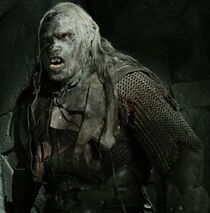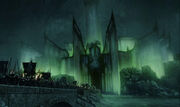- "‘There are Orcs, very many of them,’ he said. ‘And some are large and evil: black Uruks of Mordor. For the moment they are hanging back, but there is something else there. A great cave-troll, I think, or more than one. There is no hope of escape that way.’"
- —Gandalf in "Chapter 5" of The Fellowship of the Ring
The Uruks of Mordor were a stronger breed of Orc amid Sauron's forces in the Third Age.
History[]
Described as elite "black Orcs", these were the first Orc-kind in Middle-earth to be referred to as uruks, originating centuries before the Great Years when they made assaults upon Ithilien in 2475 of the Third Age.[1] (It was almost a millennium later that Saruman in Isengard bred his own breed of Uruk-hai, someties called Isengarders).
Boromir spotted Uruks of Mordor in Moria moments before the skirmish in the Chamber of Mazarbul between the Fellowship of the Ring and the many Orc-kinds inhabiting Moria.[2]
Within Mordor, some of these Uruks were stationed at the Tower of Cirith Ungol. After escaping from there, the Hobbits Frodo and Sam saw Uruks march from Durthang towards the Black Gate amidst the mass-movement of all of Sauron's remaining forces.[3]

Shagrat of Cirith Ungol
In adaptations[]
The Lord of the Rings film trilogy[]

The army of Minas Morgul had Uruks of Mordor in their ranks
In Peter Jackson's The Lord of the Rings: The Return of the King, Uruks of Mordor are frequently seen: the invented character Murgash is one of them, at the Siege of Gondor, and many others march through the Orc-camp encountered by Sam and Frodo in western Mordor. Most notably, Shagrat, in the Tower of Cirith Ungol, is portrayed as an Uruk.
Depiction[]
All Uruks depicted in the films are recognizable by their broader stature and long hair resembling that of the Isengard Uruk-hai. Gorbag was therefore depicted as a black Uruk, being instead skinny, with the natural slouch of other common Orcs.
Ambiguation in films and games[]
In some adaptations, the label of "Black Uruk" is made synonymous with Black Orc (such as in EA's The Rise of the Witch-king) or even Morannon Orc - on the grounds that all three names denote a tougher breed of Mordor-indigenous Orc.
Translations[]
| Foreign Language | Translated name |
| Afrikaans | Swart Uruks |
| Albanian | Urukë të zi |
| Arabic | الوركاءس الأسود |
| Armenian | Սև Ուրուկը |
| Azerbaijani | Qara Uruks |
| Basque | Uruks Beltzak |
| Bulgarian Cyrillic | черно Уруки |
| Catalan | Uruks Negre |
| Croatian | Crni Uruks |
| Czech | Černí Skuruti |
| Danish | Sorte uruker |
| Dutch | Zwarte Uruks |
| Esperanto | Nigraj Uruks |
| Estonian | Mustad Uruks |
| Finnish | Musta Uruks |
| French | Uruks Noir |
| Galician | Uruks Negros |
| Georgian | შავი ურუქები |
| German | Schwarze Uruks |
| Hebrew | ארךס שחורים |
| Hungarian | Fekete Uruks |
| Icelandic | Svartur Uruks |
| Indonesian | Hitam Uruks |
| Italian | Uruks Neri |
| Japanese | 黒ウルクス |
| Kannada | ಕಪ್ಪು ಉರುಕ್ಸ್ |
| Kurdish | Urukên Reş (Kurmanji Kurdish) |
| Latvian | Melnie Uruks |
| Lithuanian | Juodi Uruks |
| Macedonian Cyrillic | Црни Уруки |
| Malaysian | Hitam Uruks |
| Maltese | Uruks Iswed |
| Mongolian Cyrillic | Хар уруки |
| Nepalese | कालो उरुक्स |
| Norwegian | Svarte Uruks |
| Polish | Czarne Uruks |
| Portuguese | Uruks Negros |
| Russian | Черные Уруки |
| Serbian | Црни Урукс (Cyrillic) Crni Uruks (Latin) |
| Sinhalese | කළු උරුක්ස් |
| Slovak | Čierne Uruks |
| Slovenian | Črni Uruks |
| Spanish | Uruks Negros |
| Swedish | Svarta-Uruks |
| Turkish | Kara Uruklar |
| Uzbek | Қора Урукс (Cyrillic) Qora Uruks (Latin) |
| Welsh | Uruks Du |
| Yiddish | שוואַרץ ורוקס |
References[]
- ↑ The Lord of the Rings, Appendix B
- ↑ The Lord of the Rings, The Fellowship of the Ring, Book Two, Ch. V: "The Bridge of Khazad-dûm", pg. 338
- ↑ The Lord of the Rings, The Return of the King, Book Six, Chapter II: "The Land of Shadow"
